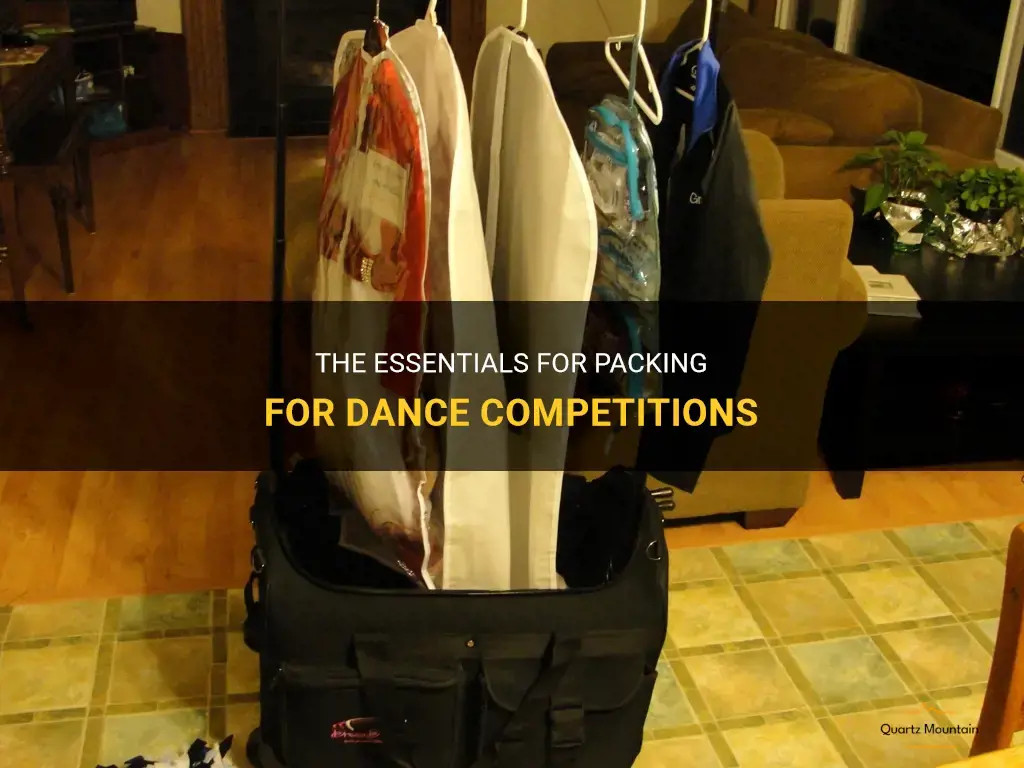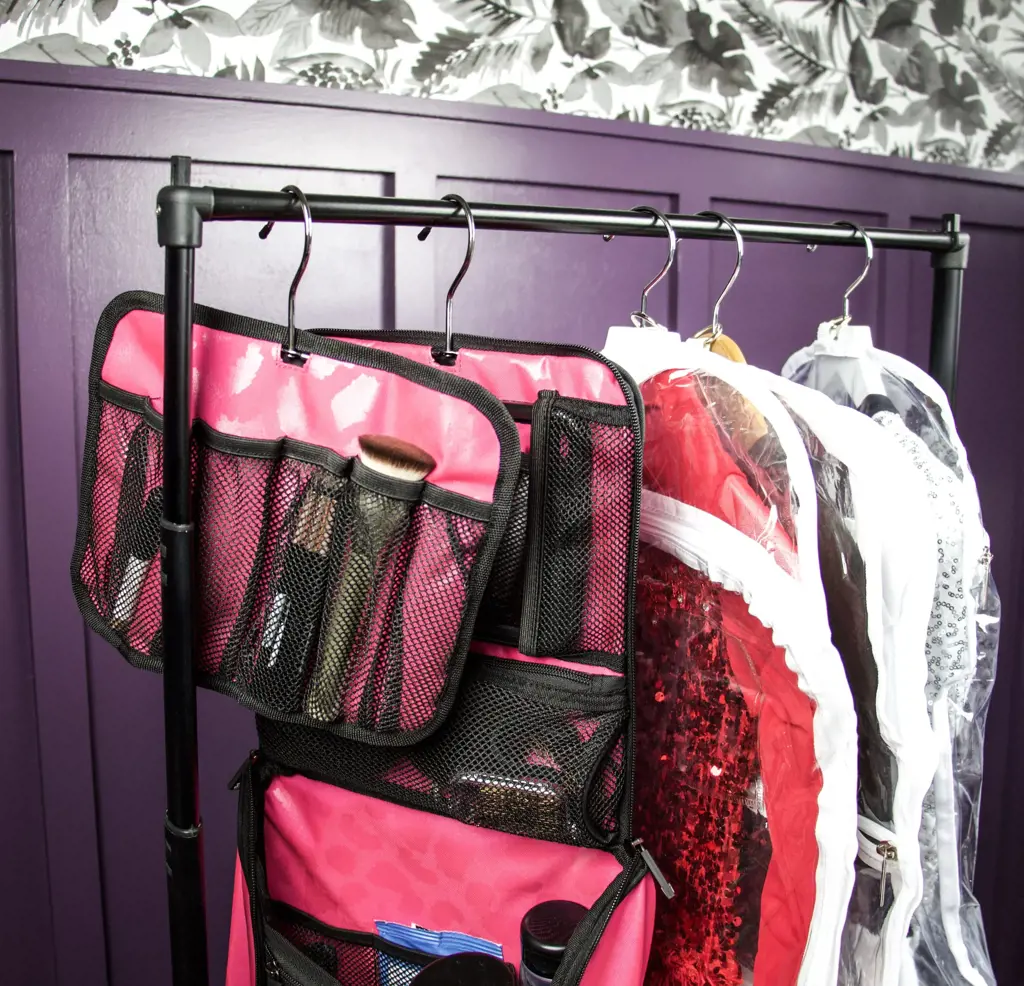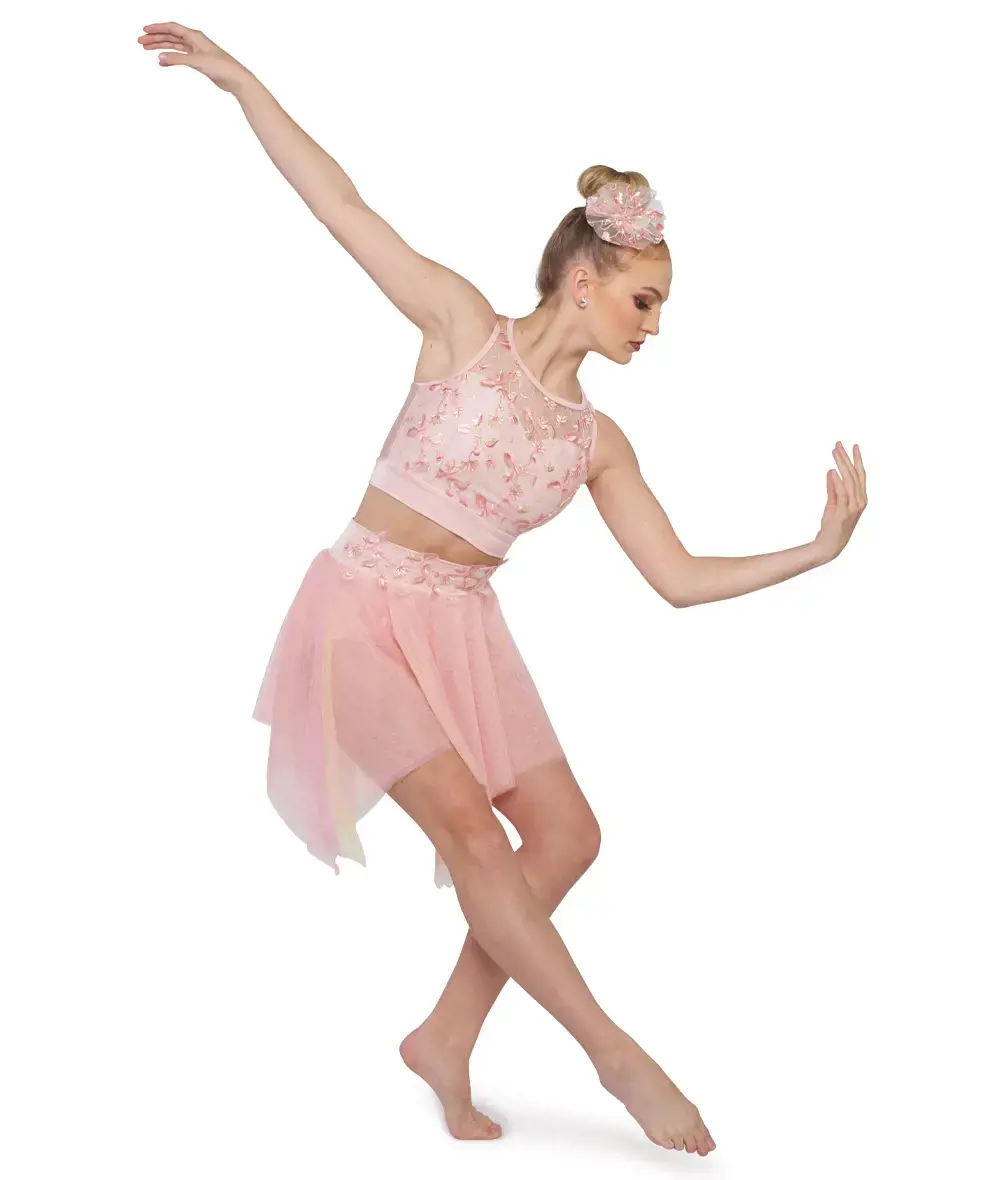
Dance competitions are exhilarating events that require dancers to bring their A-game and showcase their skills on stage. However, one crucial aspect that can often be overlooked is packing for the competition. While the focus is typically on honing dance routines and perfecting technique, having the right essentials in your bag can make all the difference. From costumes and accessories to makeup and snacks, this guide will take you through the essentials for packing for dance competitions, ensuring you're fully prepared to deliver a show-stopping performance on and off the stage. So, grab your dance bag and let's dive into the must-haves that every dancer should pack for a competition!
What You'll Learn
- What are the essential items to pack for a dance competition?
- Are there any specific clothing or shoe requirements for different styles of dance competitions?
- How many costumes should I pack for a dance competition?
- What types of dance accessories should I bring to a competition?
- Are there any recommended items to bring for pre-competition preparation and warm-up?

What are the essential items to pack for a dance competition?

Dance competitions can be an exciting and nerve-wracking experience. As a dancer, it is important to be prepared and have all the essential items packed for the competition. In this article, we will discuss the key items that every dancer should pack for a dance competition.
- Dance Attire: The most important item to pack for a dance competition is your dance attire. This includes your costume, tights, shoes, and any accessories that go with your outfit. It is essential to double-check that you have packed all the necessary pieces for each dance you will be performing. It's also a good idea to pack an extra set of tights and a spare pair of dance shoes in case of emergencies.
- Hair and Makeup Supplies: Dancers are often required to have a specific hairstyle and makeup for their performances. It is important to pack all the necessary supplies to achieve the desired look. This includes hairpins, bobby pins, hairspray, hairbrush, hairnets, makeup, brushes, and any other items you may need to style your hair and apply makeup.
- Warm-up Attire: Dance competitions can be long and intense, with dancers needing to warm up before their performances. It is essential to pack warm-up attire such as leggings, a sweatshirt, and cozy socks to keep your muscles warm and prevent injury during warm-ups and downtime between performances.
- Proper Nutrition: Dancers need to fuel their bodies with the right nutrients to perform at their best. Packing healthy snacks and meals is crucial for maintaining energy levels throughout the competition. Some good choices include fruits, vegetables, nuts, energy bars, and water. It's also important to avoid foods that may cause bloating or discomfort, such as greasy or heavy meals.
- First Aid Kit: Accidents happen, and it is important to be prepared for any minor injuries or mishaps. Packing a small first aid kit with essentials like band-aids, pain relievers, blister pads, and any necessary medications can help you deal with minor issues quickly and efficiently.
- Personal Care Items: Dancers need to look and feel their best on stage. Packing personal care items such as deodorant, baby wipes, a towel, and extra hair ties can make a significant difference in feeling fresh and confident during the competition.
- Music: Don't forget to pack your music! Whether it's on a CD, USB drive, or your phone, make sure you have a backup copy as well. It's always a good idea to have your music saved in multiple formats to avoid any technical difficulties.
- Dance Bag: Lastly, pack all these essential items in a sturdy and spacious dance bag. Investing in a good dance bag with compartments and pockets can help keep your items organized and easily accessible. It is also crucial to label your dance bag with your name and contact information to prevent any mix-ups or loss.
In conclusion, packing the essential items mentioned above is crucial for a successful and stress-free dance competition. Being prepared and having all the necessary items can help you focus on your performance and give your best on stage. So, make a checklist, pack your dance bag well in advance, and enjoy the competition!
Essential Items to Pack for a Memorable Theme Park Adventure
You may want to see also

Are there any specific clothing or shoe requirements for different styles of dance competitions?

Are you getting ready to compete in a dance competition but aren't sure what to wear? Different styles of dance competitions may have specific clothing and shoe requirements to ensure fairness and consistency. In this article, we will explore the various clothing and shoe requirements for different styles of dance competitions.
Ballet Competitions:
Ballet competitions typically have stricter dress codes compared to other dance styles. Female dancers are usually required to wear a traditional ballet tutu or leotard with tights. Pointe shoes are a must for dancers performing en pointe. Male dancers often wear fitted ballet tights or leggings with a fitted dance shirt.
Jazz Competitions:
Jazz dance competitions usually allow for more freedom in clothing choices. Female dancers often wear fitted tops, jazz pants or shorts, and jazz shoes. Some competitions may require specific colors or styles, so it's important to check the competition's rules. Male dancers generally wear fitted dance pants or shorts with a jazz shoe.
Tap Competitions:
Tap dance requires specific footwear known as tap shoes. Both male and female dancers wear tap shoes during competitions. Clothing for tap competitions may vary, but dancers often wear fitted tops and dance pants or shorts that allow for ease of movement.
Hip Hop Competitions:
Hip hop dance competitions often have a more urban and streetwear-inspired dress code. This may include baggy pants or joggers, oversized t-shirts, hoodies, and sneakers. Dancers are encouraged to express their personal style while remaining comfortable and able to move freely.
Contemporary/Lyrical Competitions:
Contemporary and lyrical dance competitions often have a more fluid and expressive style. Female dancers typically wear leotards or fitted dance tops with dance shorts or leggings. Nude or half-sole lyrical shoes are common. Male dancers often wear fitted dance pants or shorts with a fitted dance shirt.
It's essential to read the competition guidelines carefully to ensure that you meet all the clothing and shoe requirements. Some competitions may have specific guidelines regarding hairstyle, accessories, and even makeup. Adhering to these guidelines not only ensures fairness but also helps create a cohesive and professional look on stage.
In addition to meeting the clothing and shoe requirements, dancers should also consider comfort and functionality. The clothing and shoes should allow for ease of movement, flexibility, and support, depending on the style of dance. It's advisable to try out the attire and shoes during rehearsals to ensure they are comfortable and do not restrict movement.
To summarize, different styles of dance competitions have specific clothing and shoe requirements to ensure fairness and create a cohesive and professional look. From traditional ballet attire to urban-inspired hip hop outfits, dancers must adhere to the guidelines while expressing their individual style. Comfort, functionality, and adherence to competition rules are key factors to consider when choosing dance attire. So, get ready to shine on stage with the right clothing and shoes for your style of dance competition.
Essential Items to Pack for a Woman's Business Trip
You may want to see also

How many costumes should I pack for a dance competition?

When preparing for a dance competition, one of the most important factors to consider is your costumes. Your costumes not only help you stand out on stage but also enhance your performance and bring your dance routine to life. But how many costumes should you pack for a dance competition? Let's explore this question further.
- Research the competition requirements: Before you start planning your costumes, it's crucial to thoroughly research the competition requirements. Different competitions may have specific guidelines regarding the number of costumes allowed or the type of costumes that are appropriate. Make sure you read the competition rules and regulations carefully to ensure you are in compliance.
- Consider the number of performances: The number of costumes you will need to pack depends on the number of performances you are participating in. If you are only performing one routine, you may only need one costume. However, if you are participating in multiple categories or have multiple routines, you will likely need more than one costume.
- Plan for different dance styles: Consider the different dance styles you will be performing and the costumes that best complement each style. For example, if you have a contemporary routine and a jazz routine, you may need two different styles of costumes. Take into account the different movements and themes of each routine to choose appropriate costumes.
- Determine the versatility of each costume: When packing for a dance competition, it's essential to consider the versatility of each costume. Can the costume be easily modified or accessorized to fit different routines? Choosing costumes that can be adapted for multiple routines can save space in your luggage and reduce the number of costumes you need to pack.
- Don't forget backup options: It's always a good idea to have backup costume options. Accidents can happen, and costumes can become damaged or lost. Packing extra accessories, such as tights, shoes, and hairpieces, can also help ensure you have everything you need to complete your look.
- Consider practicality and ease of transportation: Keep in mind the practicality and ease of transportation when deciding on the number of costumes to pack. Consider how much space you have in your luggage and how easily you can transport your costumes to and from the competition venue. Packing multiple large, bulky costumes may not be practical, especially if you have limited storage space.
In conclusion, the number of costumes you should pack for a dance competition depends on several factors, including the competition requirements, the number of performances, the dance styles, and the versatility of each costume. By thoroughly researching the competition guidelines and planning your costumes accordingly, you can ensure that you have the right number of costumes to showcase your talent and impress the judges. Remember to always have backup options and consider the practicality of transportation when packing for a dance competition.
The Best Materials to Use for Packing Your Belongings
You may want to see also

What types of dance accessories should I bring to a competition?

When you're preparing for a dance competition, there's more to think about than just learning your routine. The right dance accessories can make a big difference in your comfort and performance on stage. Here are some essential items to consider bringing with you to a competition:
- Dance Shoes: Make sure you have the appropriate shoes for the style of dance you'll be performing. Different styles require different types of shoes, so be sure to have the correct ones for each routine.
- Dance Tights: Tights not only provide a polished look, but they also help to keep your muscles warm and supported. Choose tights that match your skin tone for a seamless appearance on stage.
- Hair Accessories: Depending on your dance style, you may need to wear your hair in a specific way. Bring hair ties, bobby pins, and any other necessary accessories to keep your hair securely in place throughout your performance.
- Makeup: Competitions often require dancers to wear stage makeup to enhance their features and ensure they're visible from a distance. Talk to your dance instructor or team coach to find out specific makeup requirements for your competition.
- Costume Accessories: Some dance routines may require additional accessories, such as hats, gloves, or jewelry, to complete the look. Make sure you have all the necessary costume pieces and accessories packed and ready to go.
- Band-Aids and First Aid Kit: Dancing can be physically demanding, and it's not uncommon to get blisters or minor injuries during practice or a performance. Pack a small first aid kit with Band-Aids, blister pads, and any other necessary supplies to tend to minor injuries quickly.
- Water Bottle: Staying hydrated is essential for dancers, especially during intense rehearsals and performances. Bring a reusable water bottle with you, so you always have a way to stay hydrated throughout the day.
- Extra Dance Clothing: It's always a good idea to have some extra dance clothes with you in case of unexpected mishaps. Spills, tears, or wardrobe malfunctions can happen, and having spare dance clothing can save the day.
- Snacks: Competitions can be long and tiring, so it's essential to have snacks to keep your energy levels up. Pack some healthy, high-energy snacks like granola bars, fruit, or nuts to keep you fueled throughout the day.
Remember to check the specific rules and regulations of the competition you're attending to ensure you're following any guidelines regarding dance accessories and costumes. Each competition may have its own set of requirements, so it's crucial to be prepared. Being organized and having all the necessary dance accessories will help you perform your best on stage and give you the confidence you need to shine.
Essential Items to Pack for a Summer Mountain Adventure
You may want to see also

Are there any recommended items to bring for pre-competition preparation and warm-up?

Preparation and warm-up are crucial steps in an athlete's pre-competition routine. These activities help to increase performance, reduce the risk of injury, and mentally prepare for the upcoming competition. To optimize the pre-competition preparation and warm-up, there are several recommended items that athletes should consider bringing.
- Foam Roller: A foam roller is a valuable tool for self-myofascial release. Athletes can use it to target specific muscle groups and alleviate any tightness or tension. By using a foam roller before a competition, athletes can improve their flexibility, mobility, and range of motion.
- Resistance Bands: Resistance bands are lightweight and portable, making them an excellent addition to a pre-competition warm-up routine. Athletes can use resistance bands to perform dynamic stretches and warm-up exercises that activate key muscle groups. These exercises help to increase blood flow, improve joint mobility, and enhance overall performance.
- Lacrosse Ball: Similar to a foam roller, a lacrosse ball can be used for self-myofascial release. Athletes can apply pressure to specific trigger points in their muscles to release tension and promote relaxation. This can be particularly useful for targeting hard-to-reach areas or relieving muscle knots.
- Stretching Strap: A stretching strap is a versatile tool that can assist athletes in achieving a deeper stretch. It can be used to improve flexibility, increase range of motion, and enhance muscle coordination. Athletes can use the stretching strap to perform static and dynamic stretches before a competition to prepare their muscles for the physical demands of their sport.
- Hand Grippers: Hand grippers are commonly used by athletes in sports that require a strong grip, such as weightlifting, climbing, and grappling. By using hand grippers during the pre-competition warm-up, athletes can activate their forearm muscles and improve their grip strength. This can be especially beneficial for athletes participating in sports where a strong grip is essential for performance, such as tennis or golf.
- Yoga Mat: A yoga mat provides a clean and comfortable surface for athletes to perform their pre-competition warm-up exercises and stretches. It can help to cushion the joints and provide stability during balance exercises. Additionally, a yoga mat can be easily rolled up and carried, making it a convenient item to bring to competitions.
- Personal Music Device: Listening to music is a popular way for athletes to mentally prepare and get into the zone before a competition. Bringing a personal music device, such as an MP3 player or smartphone, allows athletes to create a playlist of motivating songs that can help them focus, boost their mood, and increase their confidence.
In conclusion, there are several recommended items that athletes should consider bringing for their pre-competition preparation and warm-up. These items, such as foam rollers, resistance bands, lacrosse balls, stretching straps, hand grippers, yoga mats, and personal music devices, can enhance an athlete's physical and mental readiness for competition. By incorporating these items into their pre-competition routine, athletes can optimize their performance and reduce the risk of injury.
Essential Items to Pack for Your College Apartment
You may want to see also
Frequently asked questions
When packing for a dance competition, it is important to bring appropriate dance attire such as leotards, tights, dance shoes, and any necessary accessories. You should also pack any required competition costumes, along with extra pairs of tights and shoes in case of emergencies.
Yes, it is a good idea to pack personal care items such as deodorant, hair spray, bobby pins, and any necessary makeup. Remember to bring a brush or comb to keep your hair neat and tidy throughout the day.
It is always a good idea to bring some snacks and drinks to keep you energized and hydrated throughout the day. Make sure to pack healthy snacks like granola bars, fruit, and nuts. Don't forget to bring a reusable water bottle to refill throughout the day.
Besides your dance attire and personal care items, you may want to pack a small sewing kit with needles and thread for any last-minute costume repairs. It's also wise to bring extra safety pins, band-aids, and pain relievers in case of minor accidents or injuries. Additionally, bring a notebook or planner to keep track of your schedule and any important notes or reminders.
Yes, it's always a good idea to bring a portable phone charger to ensure that your phone doesn't run out of battery in case you need to communicate with your parents or teammates. Additionally, you may want to pack a camera or GoPro to capture special moments and performances at the competition.







